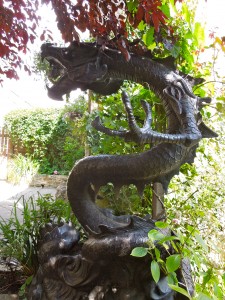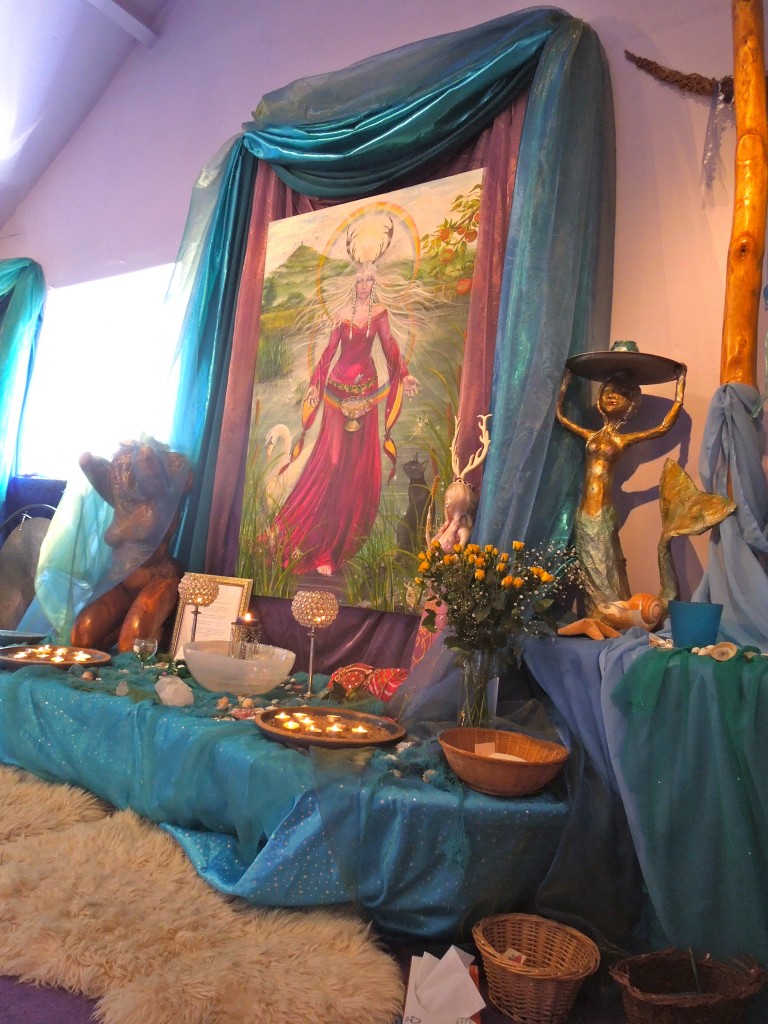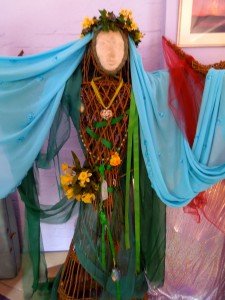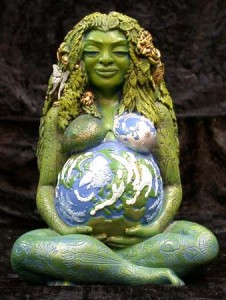
Neo-pagan dragon at the Glastonbury Experience
Dragons
Anyone who has read Joseph Campbell knows of the commonalities amongst ancient myths. Archangel Michael slaying a seven-headed dragon in the West is echoed in Japan by Susanoo slaying the eight-headed monster. The hero’s journey involves facing your inner demon, whatever the culture.
There are only two countries in the world with dragons on their flags: Bhutan and Wales. Why should a mystical fantasy creature appear on such far-flung flags? And why should the West favour a fire-eating monster whereas the East sees a benevolent emissary from on high? I can’t help thinking Christianity plays a role here, by demonising the snake and other serpent-like creatures which played an important role in pagan religions.
I once read an academic paper about the similarities between King Arthur and Yamato Takeru, a hero of the Nihon shoki. Rather than synchronicity, the suggestion was that the similarities arose from a common point of origin north-west of India, with migration routes spreading the story in different directions. Perhaps something similar happened with the dragon.

Tower on Glastonbury Tor, dedicated to the dragon-slayer Michael
Here in Glastonbury one can find two opposite uses of dragon imagery. On the top of Glastonbury Tor stand the remains of a church destroyed in an earthquake, dedicated to St Michael. As the commander of the Army of God, says the book of Revelations, archangel Michael will lead the other angels in a fight against evil, represented by a dragon.
By contrast, in the heart of the town’s lively neo-pagan community stands a statue of a Japanese-style dragon. It’s a conscious reclamation of its role as a pre-Christian symbol of wisdom and renewal. In this way the split between Western monotheism and Eastern thinking is being bridged by the spirituality of a New Age.
Uniqueness
You only have to think of the Nazis to realise that paganism can be misused for nationalistic and ultra-nationalistic reasons. Apparently something very similar is happening in contemporary Ukraine, where paganism is being utilised by those who are anti-Russian. So far neo-paganism in Britain has thankfully avoided this, being apolitical albeit firmly allied with environmental concerns.
One of the myths of primal religions is the notion of being a chosen people, and in this respect Japanese have sometimes been compared with Jews. The idea of gods favouring one particular race is obviously comforting, and as we know from State Shinto it can easily be turned into a nationalist ideology in times of war.
The idea that kami are only associated with Japan, and that only Japanese can be Shinto remains deeply embedded in the minds of some. Similar notions have been expressed about the shamanism of indigenous people, such as Native Americans, and charges of ‘appropriation’ made by Westerners who adapt the practice. However, the consequences of living in ‘a global village’ in a postmodern age mean that the argument cannot withstand the force of history. What will be, will be.

White Spring at Glastonbury - a pagan spring revived or a neo-pagan creation?
Continuity
Both Shinto and modern paganism have claims to be ancient religions with a continuous history. The idea of a link with an ancient age of lost wisdom when mankind lived in accord with nature is a seductive one. So is the notion of following age-old traditions.
However, both modern Shinto and paganism are more properly described as invented traditions. Following the restoration of the imperial system in 1868, the government artificially divided Shinto from Buddhism, setting up a new organisation designed to bolster the spiritual authority of the emperor. Folk customs like shamanism and shugendo (mountain asceticism) were outlawed; imperial ancestors were forced on local shrines as the primary kami; and ritual was prescribed to boost central control.
As for modern paganism, it has often sought to position itself as the continuation of ancient traditions. Witchcraft was said to have survived secretly into modern times, despite the ruthless persecution of the seventeenth century and later. However, studies by Ronald Hutton and others have shown that the roots lay elsewhere, such as in Theosophy, the Golden Dawn and borrowings from different traditions. It’s now generally accepted that Wicca in particular, which was the driving force of the pagan revival, is more a creation rather than a revival.

Glastonbury's Goddess Temple, first in the land for 1500 years
Mother figures
Because of a concern with patriarchy in Christianity, neo-paganism has looked to reclaim the feminine. Here in Glastonbury at this very moment a Goddess Festival is taking place, centred around the first Goddess Temple to have been established in the British Isles for some 1500 years.

Feature at the Goddess Temple, Glastonbury
Shinto too has a primal female deity, Amaterasu, but she is associated with the sun rather than the earth. How did the sun come to be female in Japan, whereas it’s decidedly male in the West? It’s an intriguing and complex question which I’d like to take up in a separate post. Suffice it to say here that Amaterasu serves as the great ancestral Mother of the imperial line, and as such is worshipped at Japan’s premier shrine of Ise.
For Joseph Campbell, the urgent need of our times was to find a modern myth, one that would fill the spiritual void of our postmodern society. Here in Glastonbury a contender can be seen in the many depictions of Gaia, a concept which derives from the personification of the earth in ancient Greece,
In 1979 the scientist James Lovelock gave the idea new impetus by suggesting the earth was in fact a living organism with a self-regulatory mechanism. By interfering with it, humans are destroying it. His hypothesis has been hailed by some as a breakthrough akin to Darwin’s theory of evolution. Here was scientific underpinning for an ancient idea and one eagerly taken up by the neo-pagans. It represents just what is needed for our times – an idea to cure us of the madness that allows the West to spend billions on war and greed while turning a blind eye to the destruction of the environment that entails. Instead of invading the Middle East, why not spend the billions on declaring war on pollution and the devastation of the Amazon rainforest?

Gaia, by Oberon Zell
**********************************************************************************************************
Information about the Goddess Temple can be found here. There are many youtube videos too featuring events from the Goddess Festival, such as this one.
For an absorbing 4-part interview with James Lovelock, see here.

Northern regions usually see the sun as female as the sun is life giving ie mothering. The Norse see the sun as female. Joseph Campell is not as highly regarded as he once was. He tried to find commonalities til he lost the bioregional tribal nature of the myths. Like Jung, I consider him another white academic who thinks he understands all humans psyches. I don’t think a Vodou follower or Lakota traditionalist or Saudi Muslim would agree with the archetypes being imposed on them. It’s a white guy POV of others from his own context and times and personal needs, like Eliade’s invention of “shamans.” The hero journey doesn’t relate to women at all. Like Eliade, woman do not exist to Jung or Campbell aside from as extras to men. Normal because they are men. If a woman created this stuff it would be very different. But women haven’t been allowed to write history, anthropology, umm life until recently.
Hitler was very against paganism. He had occultists put in the gas chambers. He wrote about how disgusting the Germans pre-Christianity were and he full support of the Catholic church for a loooong time,more than the church wants us to remember. He made some very nasty comments about Ye Olde German Pagans. It was one or two of his wackadoo entourage that were into occult stuff and somehow Hitler never was mad at them. I think because they were Christians all the way. Occultist Christians. None worshipped Frey. It was Jesus. (Frey didn’t care about the Jews.)
Every tribe I have read of has a name that basically meana the people. Outsiders, well, you never knew what the heck they could be. My Jewish friends explain the being the Chosen People means they have to be perfect with God or horrible things happen. The whole Old Testament is about that. My Rasta friends, the Ethiopian Jews, feel the same way. I have noticed that tribes that were smooshed against other tribes would change the name to “the people of the…” (name a watershed). Like the way my Celtic and Germanic ancestors often have tribes that shared a name with the river mother Goddess. Land and tribe and identity. But in more remote places being the people made sense. Any person you did not know, they could be a demon or a ghost or a God. When humans lived their normal ways and saw maybe 150 humans in their lifetime, a new face is going to cause concern.
Which is why I wonder what seeing 150 people a day in big cities as I traveled did to me? A close friend has face blindness. All humans look the same to her. After the first 300 faces, someone with face blindness cannot take in more faces. Would never have been a problem the first 99.997% of human history. Each time her kids come up to her they have to say their name. She lives in a world of strangers, people thinking she’s aloof or a snob when in reality she has no idea who is there. If I change my sweater, she has no idea who I am. I think in her I see what strangers were like to “my people.”
What a nice article! Kudos to the author for his research and effort on this website. A thank you also to Heather for insightful comments. There is so much knowledge being shared.
The dragon or snake-like divine being, I think, is universal. The Aborigine tribes of Australia have the Rainbow Serpent. Since they were essentially cut off from other cultures for 30,000 years, they are said to offer a glimpse into the state of humanity at that time–our origins, our natural souls minus the impact of technology. There is definitely a fascination and fear of snakes, with their secretiveness, “magical” properties, beauty, cleanliness and danger. Tribes everywhere adopt them as totems, notably in North America (with which I am familiar). Both folk Shinto and native American religions consider them messengers to and from the gods. My own family name, Ormsby, derives from a dragon totem in Sweden. “Orme” meant worm or snake or dragon, and “by” meant farm, and eventually village, in Britain where my Viking ancestors settled down.
I am glad to see you addressing the rightist element in paganism. Xenophobia also seems to be universal (in my experience). Dmitry Orlov, who writes on societal collapse, has said that an urge for war is also universal, as young men in particular need to prove themselves. Paganism takes us back to the local, which is necessary if we are to be good stewards of the planet (as the Bible even urges).
State Shinto was a right wing creation, with all its warring and xenophobic urges. Modern shrine Shinto is mixed–generally conservative, but the entire spectrum of people is involved. I’ve encountered some hostility among a minority. They are polite, but can be real bullies.
“Northern regions usually see the sun as female as the sun is life giving ie mothering. The Norse see the sun as female.”
That’s an interesting observation and makes a lot of sense. The thing is, Japan lies between Morocco and Portugal in terms of latitude, and is considered to be a sub-tropical region.
Just an amateur’s two cents worth, but ultimately, it may not really matter, as new growth can’t happen with only one or the other (earth or sun).